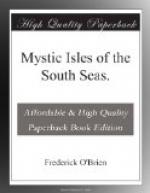This marae had not been a place of cannibalism, as the Paepae Tapu of the Marquesas Islands. The Tahitians had no record of ever having eaten humans. They replied to the first whites who asked them if they ate people:
“Do you?”
Yet when a human sacrifice was made, the presiding chief was offered the left eye of the victim, and at least feigned to eat it. Was this a remnant of a forgotten cannibalistic habit, or a protest of the Tahitians and Hawaiians against the custom as not being Polynesian, but a concession to a fashion adopted in fighting the Fijian anthropopogi?
The people of Huahine, an island near Tahiti, had a supreme god named Tane, who might be touched only by one human being, a man selected for that purpose. He was the sole bachelor on the island, being forbidden to marry. Whenever the priests wanted Tane moved to a shrine, this chap, te amo atua (the god-bearer) had to pack him on his back. The idol was a heavy block of wood, and when his bearer wearied, it had to appear that the god wanted to rest, for a god-bearer could not be tired. The missionaries burned Tane with glee, after a battle between the Christian converts and the heathen reactionaries. The progressives won, and convinced the enemy that Tane was a wretched puppet of the priests, so that they dragged the god from his lofty house, and kicked him on to his funeral pyre. “There was great rejoicing in heaven that day,” says a pious English commentator.
The Polynesians had very fixed ideas upon the origin of the universe and of man. In Hawaii, Taaroa made man out of red earth, araea, and breathed into his nostrils. He made woman from man’s bones, and called her ivi (pronounced eve-y). At the hill of Kauwiki, on the eastern point of the island of Maui, Hawaii, the heaven was so near the earth that it could be reached by the thrust of a strong spear, and is to-day called lani haahaa.
The Marquesans said that in the beginning there was no light, life, or sound in the world; that a boundless night, Po, enveloped everything, over which Tanaoa, (Darkness), and Mutu-hei, (Silence), ruled supreme. Then the god of light separated from Tanaoa, fought him, drove him away, and confined him to night. Then the god Ono, (Sound), was evolved from Atea, (Light), and banished Silence. From all this struggle was born the Dawn, (Atanua). Atea married the Dawn, and they created earth, animals, man.
In most of Polynesia there are legends of a universal flood from which few escaped. In Fiji it was said that two races were entirely wiped out, one of women, and the other of men and women with tails. A little bird sat on the top of the uncovered land and wailed the destruction. The Marquesans built a great canoe like a house, with openings for air and light, but tight against the rain. The ark was stored with provisions, and the animals of the earth were driven in two by two, fastened in couples. Then the family of four men and four women entered




